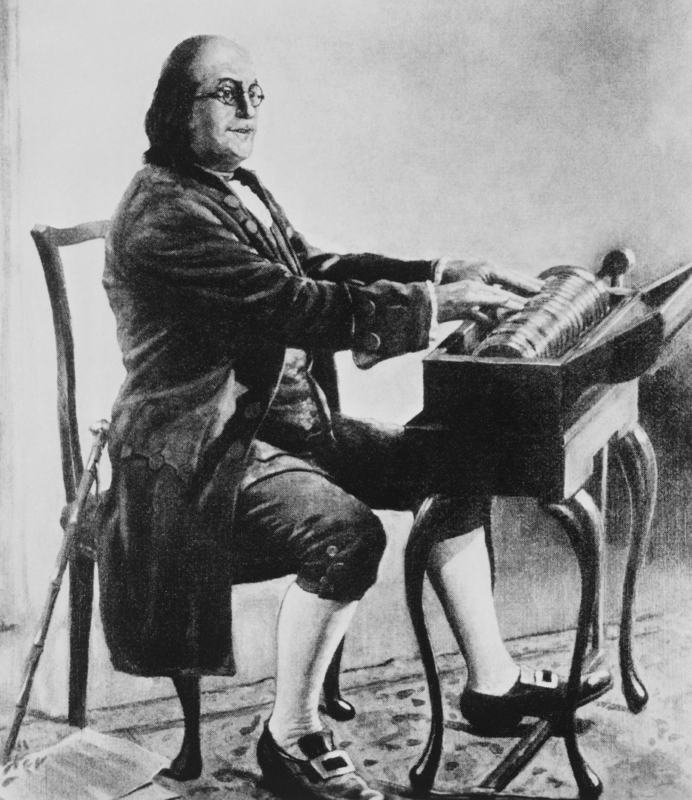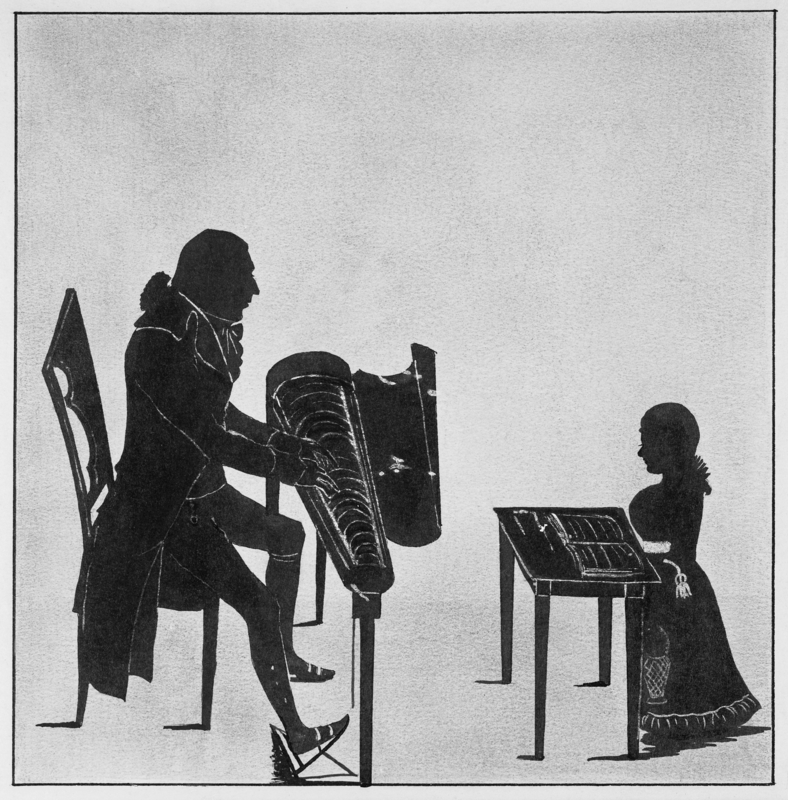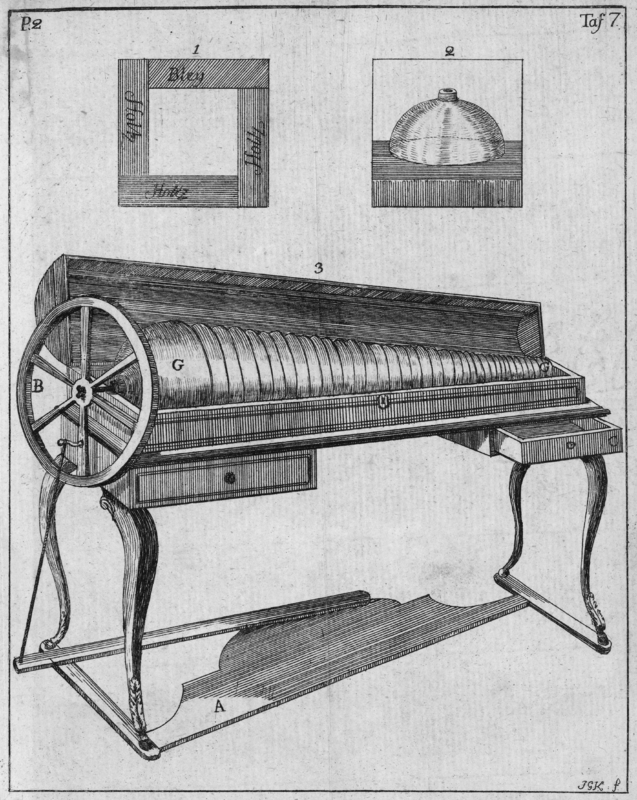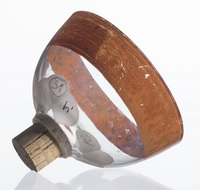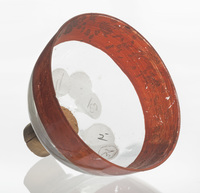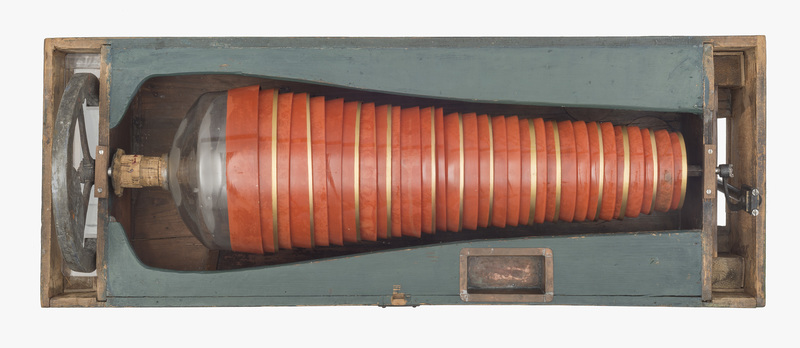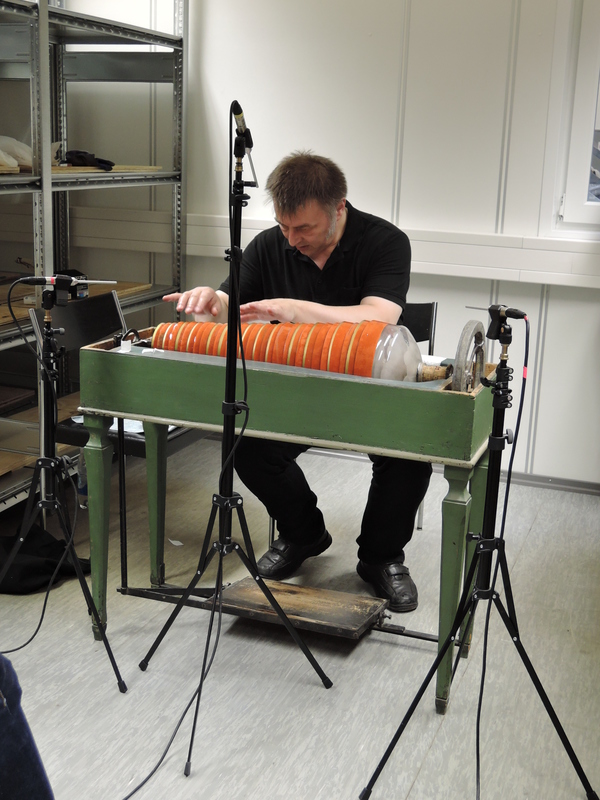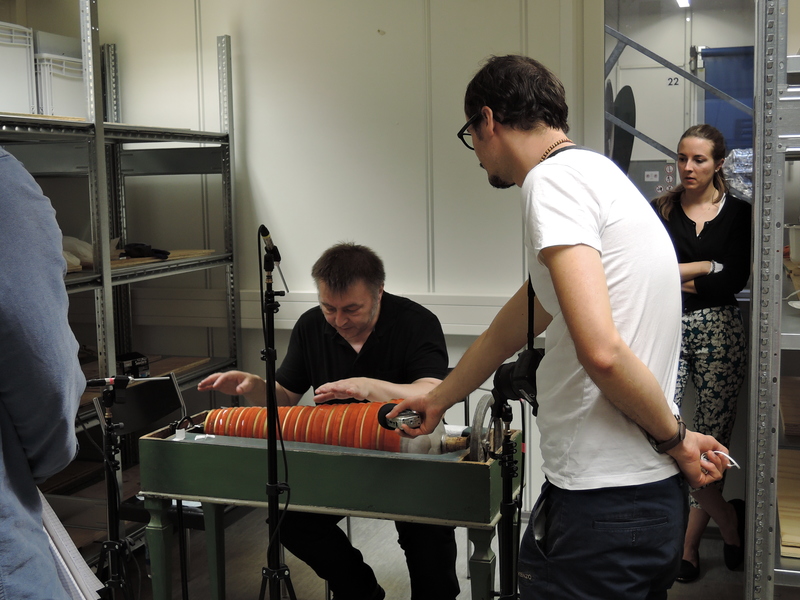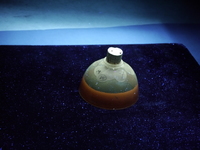Music of the spheres
Glass harmonica, manufacturer unknown, Germany circa 1800, Inv. No. 7996
Benjamin Franklin (1706-1790), naturalist, scientist and diplomat, took up the challenge of musical glasses during his time in England and constructed the first glass harmonica in 1761. Its glasses were made by the London glassblower Charles James.[10] Franklin created a new design that affected the way the instrument was played and made it more popular. Franklin gave a glass harmonica to the London-based musician Marianne Davies (1743/44-1818/19),[11] who introduced the instrument in Europe.
Details of the invention can be found in a letter written by Franklin in 1762 to his colleague Giambattista Beccaria (1716-1781), an experimental physicist in Turin. Franklin placed glass calottes of different sizes side by side on a spindle and affixed them with a cork. The instrument has a pedal for setting a flywheel in motion that rotates the spindle together with the glasses. Touching the glasses with moistened fingers now produces tones. Franklin rearranged the glasses, allowing several tones to be played simultaneously with one hand. The inventor also changed the playing position: the player is now seated at the instrument as with any other keyboard instrument. Franklin said that the instrument was not difficult to learn, as he hoped to interest a new target group in playing it: laypeople.
Franklin’s description of the instrument’s sound would shape its reception for decades to come:
Long-lasting tones that could be varied dynamically were the aim of many inventions of the time. A comparison with the human voice is obvious. Many portrayals from the following decades supported this, celebrating the sweet, heavenly tone perceived to represent the harmony of the spheres, both angelic and supernatural. The glass harmonica was said to directly affect the soul, possibly because of its penetrating sound character, but also because of its manner of playing, in which the vibrating glass domes were directly felt by the fingertips. Contemporaneous audio-physiological theories may also have contributed to these notions of the “special effects” on the soul, more precisely, the concept of how sound was transmitted to the ear and further, to the soul.[13] Thus, the glass harmonica is often played in legato and ‘sentimental’ pieces to express the supernatural, the ghostly, or madness.
Franklin traveled back to Philadelphia in 1762 and took a harmonica with him. The instrument was primarily used in England, Germany and North America. Compositions for glass harmonica would soon be written, for example, by Johann Adolph Hasse, Wolfgang Amadeus Mozart, and Karl Leopold Röllig.
The glass harmonica in the Deutsches Museum has a range of 2 ½ octaves, from f to c3. The gold-marked calottes correspond to the black keys of the piano. The instrument is hardly playable today because two glass calottes are defective and two more have been removed to protect them. The lowest playable calotte produces a G. The pedal and the mechanism towards the flywheel are largely immobile.
In idle mode, single tones and chords are playable although the instrument is slightly out of tune. Its pitch is about A426 Hz. Even though the calottes can be tuned by grinding the glass base, the tuning changes slightly after they are placed on the cork. In addition, glass is a cooled liquid that can deform further over time, which also affects the tuning.
Our recording took place on July 31, 2018 in a depot of the Deutsches Museum. Bruno Kliegl documented single tones as well as selected chords on the intact calottes.
Musical examples
The recordings were held in the presence of the Deutsches Museum PR department. Ralph Würschinger created a Podcast about the project.
Click here to play the glass harmonica.
For a material analysis of the glass harmonica click here.
Related literature on the glass harmonica
Heather Hadlock: “Sonorous Bodies: Women and the Glass Harmonica”, in: Journal of the American Musicological Society 53/3 (2000), pp. 507–542.
Freia Hoffmann: Instrument und Körper. Die musizierende Frau in der bürgerlichen Kultur, Frankfurt/M. 1991, pp. 113–130.
C. Ferdinand Pohl: Geschichte der Glas-Harmonica, Wien 1862.
Karl L. Röllig: Über die Harmonika. Ein Fragment, Berlin 1787.
Rebecca Wolf: “The Sound of Glass: Transparency and Danger”, in: Mary Helen Dupree, Sean Franzel (eds.): Performing Knowledge, 1750–1850, Berlin, Boston 2015, pp. 113–136.
[11] For biography see https://www.sophie-drinker-institut.de/davies-marianne
[12] Benjamin Franklin to Giambatista Beccaria, 13.7.1762, in: Leonard W. Labaree/Whitfield J. Bell (eds.): The Papers of Benjamin Franklin, New Haven et al.: Yale University Press 1966, Vol. 10, p. 130.
[13] On the glass harmonica, playing style, protagonists and sensual effect, see Freia Hoffmann: Instrument und Körper. Die musizierende Frau in der bürgerlichen Kultur, Frankfurt: Insel 1991; Stefan Drees: “'Sphärenmusik' und 'Gräberton'. Zum Bedeutungsgefüge von Glasklängen”, in: Neue Zeitschrift für Musik 170/5 (2009), pp. 24–29; Gerhard Finkenbeiner/Vera Meyer: “The Glass Harmonica: A Return from Obscurity”, in: Leonardo 20/2 (1987), pp. 139–142; A. Hyatt King: “The Musical Glasses and Glass Harmonica”, in: Proceedings of the Royal Musical Association (1946–1946), pp. 97–122; James Kennaway: Bad Vibrations. The History of the Idea of Music as a Cause of Disease, Farnham, Surrey et al.: Ashgate 2012; Heather Hadlock: “Sonorous Bodies: Women and the Glass Harmonica”, in: Journal of the American Musicological Society 53/3 (2000), pp. 507–542.
Citation: Rebecca Wolf, ‘Glass sounds or the fascination of transparency’, in: Materiality of Musical Instruments. A Virtual Exhibition.

